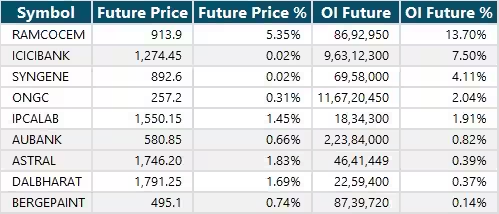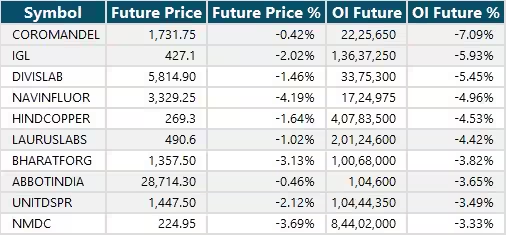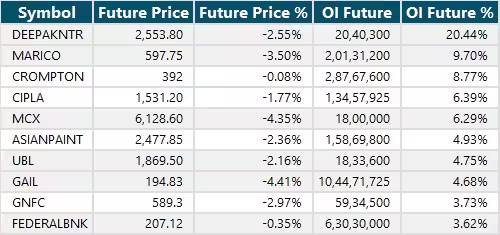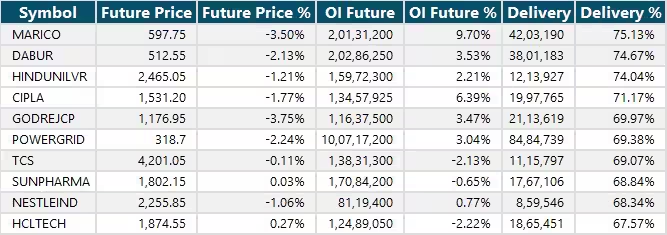13 Nov , 2024 By : Debdeep Gupta

Nifty Under Pressure
The Nifty 50 nosedived sharply after increased volatility in the last couple of sessions, falling more than one percent on November 12 following weakness in global peers. The long bearish candlestick, coupled with the formation of lower lows and weak momentum indicators, are the key drivers of this move. The index is now near the 23,800 support level. If it decisively breaks this level, the likely selling pressure could drive the index down to 23,500. Meanwhile, resistance is placed in the 24,000-24,200 zone, experts said
Here are 15 data points we have collated to help you spot profitable trades:
1) Key Levels For The Nifty 50 (23,884)
Resistance based on pivot points: 24,142, 24,237, and 24,391
Support based on pivot points: 23,834, 23,739, and 23,585
Special Formation: The Nifty formed a long bearish candlestick pattern with the continuation of lower lows for the fourth consecutive session. The momentum indicators, including the RSI (Relative Strength Index) and MACD (Moving Average Convergence Divergence), showed negative crossovers, while the index remained below all key moving averages (except the 200-day EMA), indicating increasing nervousness in the market.
2) Key Levels For The Bank Nifty
Resistance based on pivot points: 51,889, 52,163, and 52,607
Support based on pivot points: 51,001, 50,726, and 50,282
Resistance based on Fibonacci retracement: 52,353, 52,852
Support based on Fibonacci retracement: 50,298, 49,303
Special Formation: The Bank Nifty formed a large bearish candle on the daily charts, signaling weakness. The lower lows formation persisted for the fourth consecutive day, and the index is now trading below the 20-, 50-, and 100-day EMAs with a negative crossover in the RSI. The index fell 719 points, or 1.4 percent, to 51,158.
3) Nifty Call Options Data
According to the weekly options data, the maximum open interest was seen at the 24,500 strike (with 99.2 lakh contracts). This level can act as a key resistance level for the Nifty in the short term. It was followed by the 25,000 strike (94.41 lakh contracts), and the 24,200 strike (79.39 lakh contracts).
Maximum Call writing was observed at the 24,000 strike, which saw an addition of 50.67 lakh contracts, followed by the 24,200 and 24,100 strikes, which added 35.57 lakh and 33.06 lakh contracts, respectively. The maximum Call unwinding was seen at the 24,800 strike, which shed 4.11 lakh contracts, followed by the 24,900 and 23,300 strikes which shed 69,900, and 2,925 contracts, respectively.
4) Nifty Put Options Data
On the Put side, the 23,000 strike holds the maximum open interest (with 61.12 lakh contracts), which can act as a key support level for the Nifty. It was followed by the 23,500 strike (44.4 lakh contracts), and the 24,000 strike (31.38 lakh contracts).
The maximum Put writing was placed at the 23,200 strike, which saw an addition of 4.45 lakh contracts, followed by the 23,900, and 23,400 strikes, with 3.64 lakh, and 1.95 lakh contracts added, respectively, while the maximum Put unwinding was seen at the 24,200 strike, which shed 11.35 lakh contracts, followed by the 24,100 and 24,000 strikes which shed 8.9 lakh and 7.5 lakh contracts, respectively.
5) Bank Nifty Call Options Data
According to the weekly options data, the maximum open interest was seen at the 52,500 strike, with 47.42 lakh contracts. This can act as a key resistance level for the index in the short term. It was followed by the 52,000 strike (43.38 lakh contracts) and the 51,500 strike (25.83 lakh contracts).
Maximum Call writing was visible at the 52,000 strike (with the addition of 22.17 lakh contracts), followed by the 51,500 strike (20.66 lakh contracts) and the 52,500 strike (19.86 lakh contracts), while the maximum Call unwinding was seen at the 50,000 strike, which shed 29,805 contracts.
6) Bank Nifty Put Options Data
On the Put side, the 50,000 strike holds the maximum open interest (with 29.09 lakh contracts), which can act as a key support level for the index. This was followed by the 50,500 strike (20.5 lakh contracts) and the 51,000 strike (16.72 lakh contracts).
The maximum Put writing was observed at the 50,300 strike (which added 8.98 lakh contracts), followed by the 50,000 strike (7.6 lakh contracts) and the 50,400 strike (5.89 lakh contracts), while the maximum Put unwinding was seen at the 51,600 strike, which shed 10.96 lakh contracts, followed by the 51,400 and 51,500 strikes, which shed 7.38 lakh and 6.92 lakh contracts, respectively.
7) Funds Flow (Rs crore)

8) Put-Call Ratio
The Nifty Put-Call ratio (PCR), which indicates the mood of the market, dropped to 0.72 on November 12, from 0.91 level in the previous session.
The increasing PCR, or being higher than 0.7 or surpassing 1, means traders are selling more Put options than Call options, which generally indicates the firming up of a bullish sentiment in the market. If the ratio falls below 0.7 or moves towards 0.5, then it indicates selling in Calls is higher than selling in Puts, reflecting a bearish mood in the market.
9) India VIX
Volatility increased slightly after the downtrend in the previous sessions, adding to the discomfort for bulls. The India VIX, the fear index, rose by 2.24 percent to 14.59, up from 14.27 levels.
10) Long Build-up (9 Stocks)
A long build-up was seen in 9 stocks. An increase in open interest (OI) and price indicates a build-up of long positions.

11) Long Unwinding (74 Stocks)
74 stocks saw a decline in open interest (OI) along with a fall in price, indicating long unwinding.

12) Short Build-up (81 Stocks)
81 stocks saw an increase in OI along with a fall in price, indicating a build-up of short positions.

13) Short-Covering (19 Stocks)
19 stocks saw short-covering, meaning a decrease in OI, along with a price increase.

14) High Delivery Trades
Here are the stocks that saw a high share of delivery trades. A high share of delivery reflects investing (as opposed to trading) interest in a stock.

15) Stocks Under F&O Ban
Securities banned under the F&O segment include companies where derivative contracts cross 95 percent of the market-wide position limit.
Stocks added to F&O ban: Nil
Stocks retained in F&O ban: Aarti Industries, Aditya Birla Fashion & Retail, Granules India, Hindustan Copper, Manappuram Finance
Stocks removed from F&O ban: Nil
0 Comment